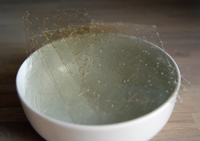
Photo from wikipedia
As an attempt to establish a method for efficient and safe administration of therapeutic carbon monoxide (CO) to the human body, supramolecular nanoplatforms incorporated with CO-releasing molecules (CORMs) have recently… Click to show full abstract
As an attempt to establish a method for efficient and safe administration of therapeutic carbon monoxide (CO) to the human body, supramolecular nanoplatforms incorporated with CO-releasing molecules (CORMs) have recently been developed. In particular, hydrogel scaffolds have attracted considerable attention due to the possibility of site-specific and controlled liberation of CO. However, it would be greatly beneficial to enhance the mechanical strength of hydrogels to widen their applicability in biomedical, pharmaceutical, and surgical sectors. Herein, we report a visible light-mediated crosslinkable supramolecular CO-releasing hydrogel (CORH), based on the fibrillar assembly of elastomeric protein-derived tyrosine-containing short peptides. A photo-driven dimerization of tyrosine moieties located on the fibrillar surface of CORH, accelerated by a Ru-based catalyst, results in the entanglement and bundling of nanofibrils that significantly increases the mechanical strength and stability of the CORH, which allows prolonged CO-liberation through limiting the contact of CORMs with water molecules. The contact probability of a CORM with water determined by the spatial position of the CORM on the fibrils containing a crosslinkable tyrosine moiety that affects CO-releasing behavior was confirmed by adjusting the CORM position closer to or farther from the tyrosine in the peptide sequence. A bulky CORM closely located to the tyrosine in a peptide inhibited the effective dityrosine formation of tyrosine on the fibril surface, resulting in loose bundling of nanofibrils in the CORH and facilitating the release of CO through the exchange with water. The photo-crosslinked CORH demonstrated a potent cytoprotective effect on oxidatively stressed cardiomyocytes, as expected. This work could provide a useful insight for the practical application of gasotransmitters as functional nanomaterials in pharmaceutical and biomedical fields.
Journal Title: Nanoscale
Year Published: 2019
Link to full text (if available)
Share on Social Media: Sign Up to like & get
recommendations!